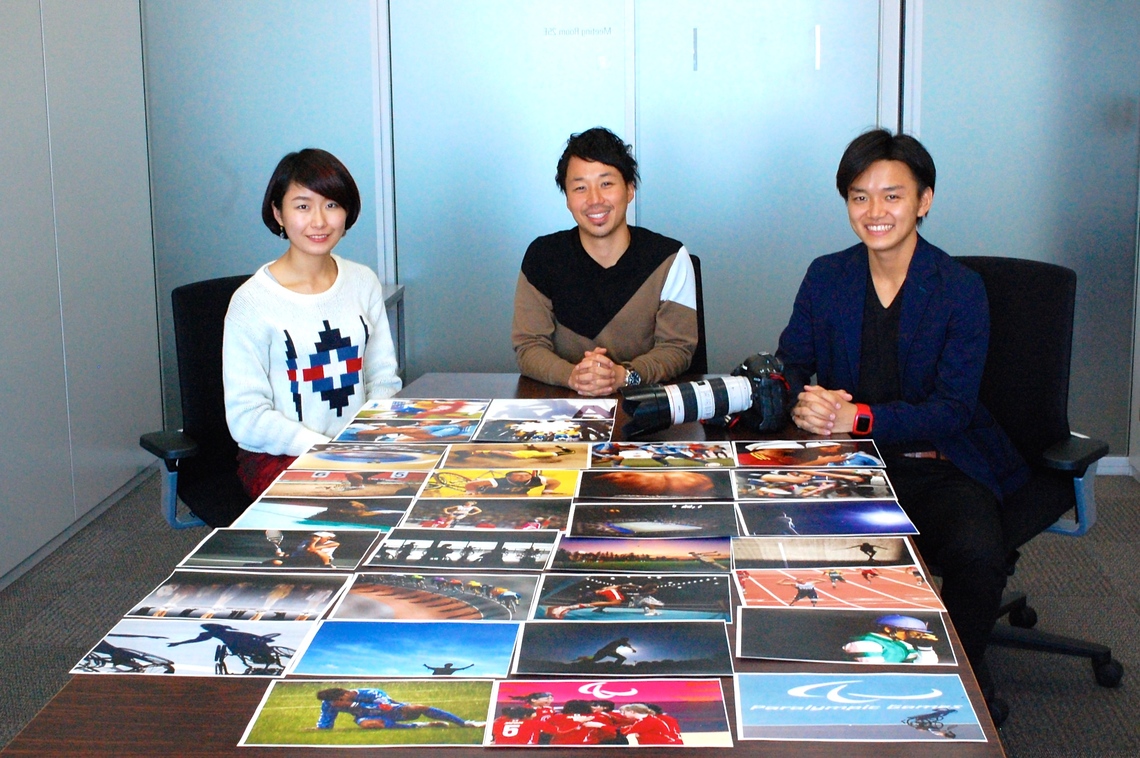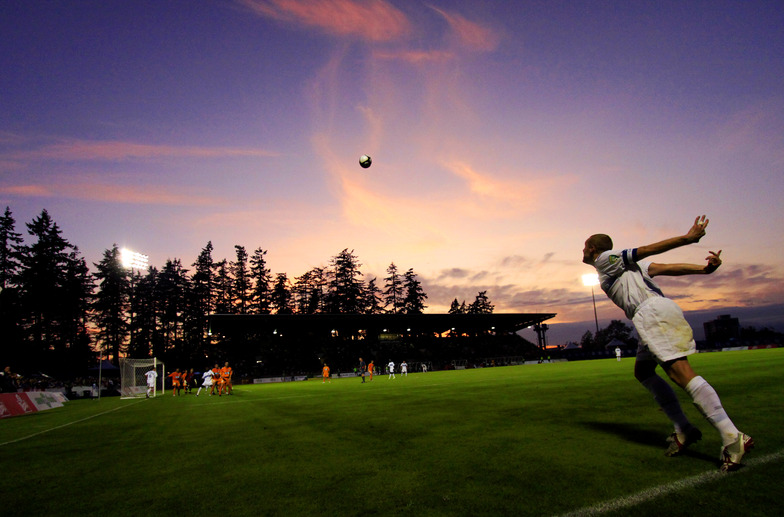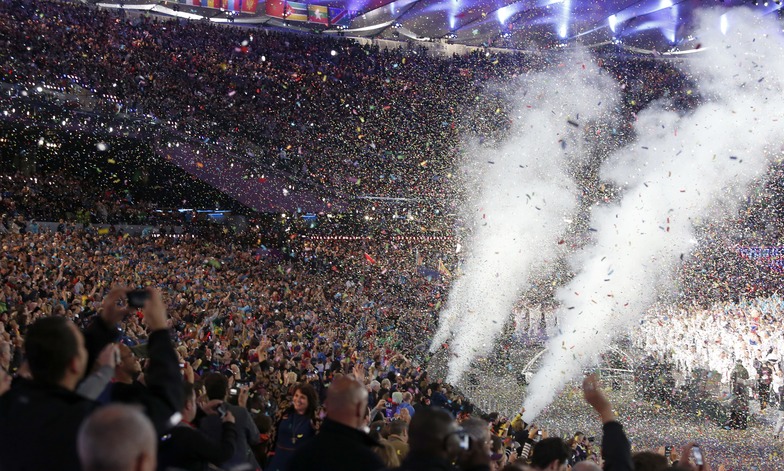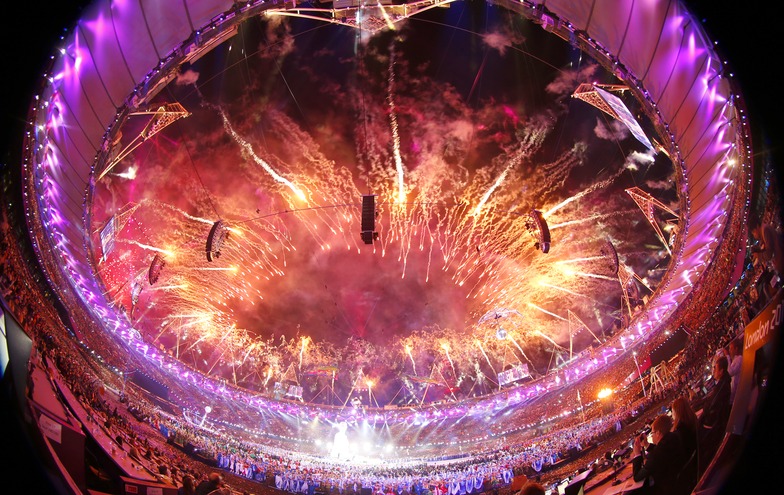In Tokyo 2020, significant attention is expected not only for the Olympics but also for the Paralympics.
In this series, Dentsu Inc. members moved by parasports (sports for athletes with disabilities) welcome photographer Shugo Takemi to introduce the appeal of the Paralympics and parasports through vivid, immersive photographs.
With passion, we aim to share the growing interest in parasports in Japan, encouraging more people to enjoy them and support the 2020 Tokyo Paralympics.

From left: Ami Ito (Dentsu Inc.), Akihiro Tani (Dentsu Inc.), Shugo Takemi (Photographer)
Tani: Through my sports-related work at Dentsu Inc., I developed an interest in the Paralympics and parasports. I want to share their appeal with like-minded members I met through this project.
For this first installment, we'd like to hear from Mr. Takemi, who will be the main focus of this series.
I met Mr. Takemi through work, but I myself am someone deeply moved and strongly influenced by his photography.
As a sports photographer, Takemi-san covers various sporting events, including the Japanese national soccer team, while also pursuing photography of parasports as his life's work. He also served as an official photographer for the Tokyo 2020 Olympic and Paralympic Games Bid Committee. The photographs used in that bid presentation were taken by Takemi-san.
Mr. Takemi, could you give us a brief introduction and share your thoughts on this series?
Takemi: I'm Shugo Takemi, a photographer.
I've been taking sports photos since my student days, but it was during my work for the 2010 Vancouver Olympics and Paralympics that I encountered disabled sports. I was captivated then, and it has been my theme ever since.
With the 2020 Tokyo Olympics and Paralympics now confirmed, and the Paralympics starting to get the spotlight, I feel this is a once-in-a-lifetime opportunity to introduce people to para sports. This series can deliver information to people who don't normally encounter para sports, so I hope it becomes a catalyst for sparking interest in more people.
Tani: Sharing information is important, but fostering a positive desire to actually go see the events is truly crucial, right?
Next is Ito, a strategic planner at Dentsu Inc. With her extensive experience in diversity-related work, I believe she can offer insights from a slightly different perspective.
Ito: I'm involved in an internal project at Dentsu Inc. called the Diversity Lab. We work with the hope of creating a world where everyone can live comfortably, embracing their true diversity and individuality.
I hadn't seen much para-sports before, but seeing Takemi's photos really resonates with me and makes me feel the power of sport.
In this series, I'll be taking on the role of a beginner, posing questions to both of you and deepening my understanding as the series progresses, while also sharing what I learn with everyone.
Through sports photography, I want to convey the Paralympics as "interesting as a sport."
Ito: Taniguchi, when it comes to conveying the appeal of the Paralympics, could you tell us why you focused on Takemi's photos?
Tani: There's one of Takemi's photos showing a child watching a triathlon race. When I first saw this photo, I was deeply moved, thinking it truly captured the essence of what makes sports so moving.
The child in the photo has an expression full of wonder and respect. I felt this captures the very first experience of being moved by sports.
Takemi: Thank you.
This photo captures a moment from the Paralympic triathlon event held in Yokohama. I spotted a child cheering with such a wonderful expression.
For children this young, whether an athlete has a disability or not doesn't matter. I captured this moment because I saw a child watching the sport live, cheering passionately for the athletes, feeling the excitement of competing alongside them.
When taking photos, I always focus above all on visually conveying the dynamism of the moment, regardless of whether the athlete has a disability or not.
Ito: As an amateur, I thought it was unusual in sports photography to focus on capturing the expressions of the children watching rather than the athletes themselves.
Takemi: Beyond capturing athletes' vivid expressions of emotion, I want to convey the immediacy, intensity, and humanity of the moment. I believe the appeal of sports isn't just from the athletes themselves, but also from the spectators and the people supporting them around the field.
Not limited to parasports, I want to keep challenging myself to take sports photos that make people intuitively think, "I want to see that match live" or "I want to try that myself."
Tani: Takemi's photos don't focus on prosthetic limbs or wheelchairs; they offer other perspectives, letting you imagine the athletes' incredible skill and the emotions of those watching. They make you realize that sports have the power to shatter preconceptions in an instant.
I felt Takemi's photos were perfect for conveying the appeal of para sports in a way that's easy to understand.
We want to recreate the moving scenes we saw at the London Opening Ceremony here in Tokyo.
Ito: Now, I'd like to explore why you two are so captivated by parasports. While you've always loved sports, what sparked your pursuit of the Paralympics and parasports as a life's work? Was it a particularly moving match or interaction with an athlete?
Takemi: As I mentioned earlier, my first encounter with para sports was during the Vancouver Paralympics. I was there for work, photographing events, but at the time, I myself was injured and couldn't move as I wanted. Watching a Paralympic match for the first time in that situation, I thought, "What on earth is happening?!" I'd heard the term "Paralympics" before, but I'd never had the chance to see it. It was a truly shocking encounter.
Ito: I see. It's true that even when you watch para sports normally, there's an element of surprise and the unknown. But seeing it when you're in a similar situation yourself must heighten the empathy and the sense of how incredible it really is.
Takemi: Exactly.
Also, during the recent London Games opening ceremony, the sight of the stadium audience was incredibly moving. The moment the Paralympians entered, the stadium erupted with the loudest cheer of the day – it felt like the whole place was shaking. The stands seemed filled more with Londoners than foreigners, but from the packed, standing-ovation crowd, I strongly felt the intense, respectful gaze directed at the Paralympians. The athletes' smiles, as if responding to that, were brimming with confidence, and the Union Jack proudly shone on the wheels of their wheelchairs.
It was a truly magnificent sight.
I truly hope to see this scene in Tokyo too. It has become my ideal vision.
(Continued in Part 2)
Shugo Takemi's photo exhibition "para-graphy" is currently on display. If you're interested, please visit the venue.
●Canon Gallery Umeda: Thursday, February 12, 2015 - Wednesday, February 18, 2015
●Canon Gallery Sendai: Thursday, March 5, 2015 - Tuesday, March 17, 2015










